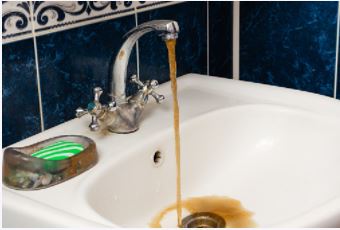In 2014 residents of Flint in Michigan started to complain about the quality of their tap water. It had become brown, looked rusty, and smelled terrible.
This happened right after the city switched from Detroit water to Flint River water to save money.
After claiming the water had been tested and was safe to drink, officials admitted the water contained high lead levels in some areas. Corroding pipes hadn’t been treated properly, and lead was being released as the water was flowing through.
Thousands of people were affected, including children, creating strong distrust for officials among the Flint residents. However, the issue was so severe that it hit the national headlines, creating a massive backlash across the country. Millions rallied behind the fight of Flint residents for safer drinking water.
This was one of too many scandals involving poor water treatment and management.
The Water Crisis in St.Joseph, Louisiana
Shortly after the Flint water crisis, residents of St. Joseph in Louisiana complained of the same issue.
In fact, the city had been experiencing poor quality drinking water and management for over ten years. And to back up their claims and encourage city officials to act, they posted hundreds of repulsive images of yellow and brown dirty water flowing from kitchen taps, washing machines, and bathtubs on social media. Some locals also described the smell of tap water as metallic.
The water quality in St. Joseph was so poor at the time that, in 2012, the town came under boil notice to avoid water-borne diseases.
Why was the water so low quality?
The answer is simple; at the time, pipe infrastructure in the town was over 90 years old, which means corroded pipes were releasing iron into the water as it flowed through.
According to city officials, the murky brown water color was due to the high concentration of iron. They tried to reassure the public, insisting such levels weren’t harmful to residents’ health. The concentration of iron in St. Joseph’s water supply was measured in 2013 and sat at 0.97 mg/L. However, the EPA’s (environmental protection agency) recommended maximum contaminant level is 0.3 mg/L. Therefore, the water in St. Joseph contained three times the recommended level of iron.
And unfortunately, research has shown that a large intake of iron in drinking water can lead to severe health issues such as:
- Hemochromatosis
- Stomach problems
- Liver damage
- Pancreas and heart damage
- Diabetes
Because of a lack of funding and a very small population, the problem had been ongoing for years, with frequent water pipe breakages and residents reporting yellow or brown tap water every week.
In 2016, a new water crisis occurred in St. Joseph. The governor had to issue a public health emergency warning to the 1,100 residents not to use tap water for drinking or bathing due to high levels of lead detected in some areas. In fact, 22% of homes and offices in town had toxic lead levels in their tap water. Lead has been proven to cause serious health issues, including lower IQ and anemia.
After spending millions on fixing the issue and upgrading the pipe infrastructure, the water is now safe for residents to drink. However, understandably, many of them are still wary, years later.
How to Ensure Your Tap Water Is Safe to Drink in St. Joseph, Louisiana?
Contact Your Water Supplier
Every year, by the 1st of July, you should receive the Annual Water Quality Report from your water supplier. This report highlights contaminant levels and overall water quality in your area. Alternatively, if you don’t receive these reports, you can access them on the National Drinking Water Database.
You can also call your local health department or municipality and request access to the latest water quality report.
Test The Water Quality Regularly
Did you know that you could test the quality of your tap water yourself?
That’s right. You can purchase an inexpensive home water testing kit online to test for specific contaminants such as:
- Iron
- Lead
- Chlorine
- Copper
- Pesticides
- pH
- Hardness
- Nitrates
- Total dissolved solids
- Coliform bacteria
- Arsenic
These tests come in various formats, but the easiest and most popular ones are test strips. With a water test strip, all you need to do is dip the strip in a glass of water for a few seconds or minutes and compare the colors on the strip to a color chart. This will tell you what contaminants are present in your tap water if any, and to what level.
Invest in a High-Quality Water Filtration System
There are many water filters on the market that can effectively remove contaminants from your tap water. From water pitchers to faucet filters and reverse osmosis filtration systems, you’ll find an option that fits your needs and budget.
However, keep in mind that not all filters are created equal. The best filters to remove chemicals and contaminants from your drinking water use reverse osmosis.
This water treatment process uses pressure to force water through a semipermeable membrane that attracts larger and unwanted molecules and only lets pure water molecules through, providing your home with tap water free from contaminants.
At Filtersmart, we’re committed to providing our clients with high-quality filtration systems, including reverse osmosis filters, to ensure they get access to safe, clean, and healthy drinking water. So, if you're concerned about the quality of your tap water, don’t hesitate to get in touch! We’d be happy to help.





